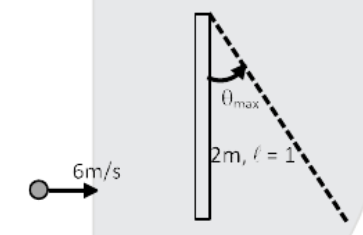
Find maximum angular displacement of rod. if particle sticks after collision.
63∘
69∘
53∘
59∘
The correct Answer is:A
Step by step video, text & image solution for Find maximum angular displacement of rod. if particle sticks after collision. by Physics experts to help you in doubts & scoring excellent marks in Class 12 exams.
Updated on:21/07/2023Similar Questions
A rod of mass 2kg and length 1m is pivoted at one end A and kept on a smooth surface. A particle of mass 500gm strikes the other end B of the rod and sticks to the rod. If particle was moving with the speed of 20m//s , what is the angular speed of the rod after collision ?
View SolutionA uniform rod of length lambda lies on a smooth horizontal table A particle moving on the table has a mass m and a speed v before the collision and it sticks to the rod after the collision. The rod has a mass M then find out. The velocity of the centre of mass C and the angular velocity of the system about the centre of mass after the collision.
View SolutionRod particle collisions and Angular Impulse
View SolutionA rod of mass 'm' and length l in placed on a smooth table. An another particle of same mass 'm' strikes the rod with velocity v_(0) in a distance perpendicular to the rod at distance x(lt l//b) form its centre. Particle sticks to the rod. Let omega be the angular speed of system after collision, then find maximum possible value of i,pulses (by varying x) that can be impartd to the particle during collision Particle still sticks to the rod.
View SolutionPassage - II : A long slender rod of mass 2kg and length 4m is placed on a smooth horizontal table. Two particles of massless 2kg and 1kg strike the rod simultaneously and stick to the rod after collosion as shown in Angular velocity of the rod after collision is
View SolutionA rod of mass m and length l in placed on a smooth table. An another particle of same mass m strikes the rod with velocity v_(0) in a direction perpendicular to the rod at distance x( lt l//2) from its centre . Particle sticks to the end. Let omega be the angular speed of system after collision , then Find the maximum possible value of impulse (by varying x) that can be imparted to the particle during collision. Particle still sticks to the rod.
View SolutionA uniform rod of length L lies on a smooth horizontal table. The rod has a mass M. A particle of mass m moving with speed v strikes the rod perpendicularly at one of the ends of the rod sticks to it after collision.
Find the velocity of the particle with respect to C before the collision
View Solution

